If your website traffic is flat, your leads are inconsistent, or your SEO team keeps jumping from one task to the next, what you’re missing isn’t effort. Its structure. A clear SEO roadmap brings direction to chaos, helping teams focus on what moves the needle instead of chasing every shiny tactic.
This guide outlines how to build an SEO roadmap that supports execution: from audits and prioritization to ownership and iteration. You’ll find practical steps and tools to plan SEO work that drives results.
- A clear SEO roadmap turns scattered tasks into structured, goal-driven execution tied to business outcomes.
- SMART goals and focused KPIs help teams measure what matters — from traffic growth to qualified conversions.
- Prioritization frameworks like the impact-effort matrix ensure teams act on high-value, low-effort SEO opportunities first.
- Regular roadmap reviews aligned with algorithm changes and competitor trends keep your SEO strategy adaptive and resilient.
What Is an SEO Roadmap?
An SEO roadmap is not a static checklist. It’s a dynamic plan that translates business goals into prioritized tasks, with clear SEO timelines, responsibilities, and measurable outcomes. From technical optimization improvements to content rollouts, the roadmap ensures everything is aligned toward long-term visibility and growth. Unlike one-off audits or quick fixes, a roadmap brings consistency and visibility to your entire SEO process.
A well-built roadmap includes the following:
- Clear goals tied to business outcomes
- Specific SEO tasks grouped by priority
- Defined SEO timeline and owners
- Built-in checkpoints to review performance
For example, a SaaS company might use its roadmap to phase a multi-step strategy: fixing crawlability issues first, then launching a quality content hub around long-tail product keywords, followed by a backlink acquisition sprint. Every task supports not only rankings, but also conversions, retention, and measurable SEO ROI.
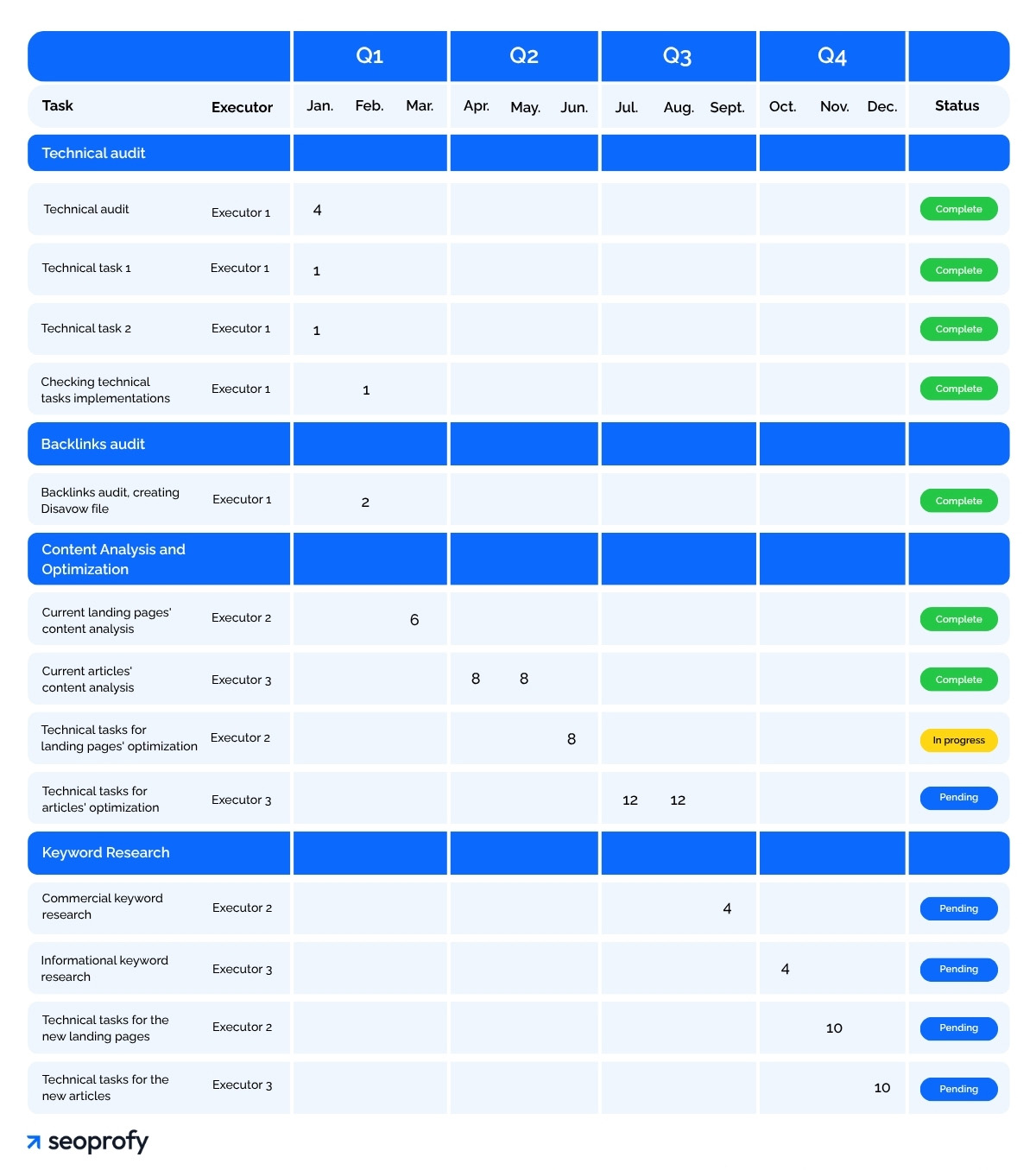
Why an SEO Roadmap Is Important
A roadmap isn’t just helpful — it’s what enables teams to consistently achieve SEO outcomes at scale. About 88% of marketers who have a documented SEO roadmap strategy plan to continue or increase their SEO investment. Without clear direction, SEO efforts become reactive, fragmented, and difficult to track.
Here’s why it matters:
- Aligns SEO with business goals: Every SEO decision should serve a bigger purpose. A roadmap ensures your keyword research, content, and technical fixes directly support revenue, leads, or market visibility.
- Improves cross-team collaboration: SEO touches multiple teams — dev, content, design. When everyone sees what’s coming and who owns what, execution becomes smoother and faster.
- Enables better resource allocation: From budgets to bandwidth, you’ll know where to focus your time and money. No more chasing quick wins at the cost of long-term growth.
- Future-proofs your strategy: Staff changes, algorithm updates, shifting goals — a well-built roadmap helps you adapt without starting from scratch.
SEO Roadmap vs. SEO Strategy
Although often used interchangeably, an SEO roadmap and an SEO strategy are two distinct components of your search engine optimization efforts — and both are essential.
Your SEO strategy defines the overarching vision. It outlines the why: the business goals you aim to achieve through SEO — such as boosting organic traffic, outranking competitors, or driving lead generation through search visibility.
The SEO roadmap is the tactical companion to that vision. It translates strategic goals into a sequence of well-defined, time-bound actions, assigning responsibility and setting expectations for execution. In other words, the roadmap translates your strategy into:
- Tasks to complete
- Timeline for delivery
- Assigned owners
- Metrics for success
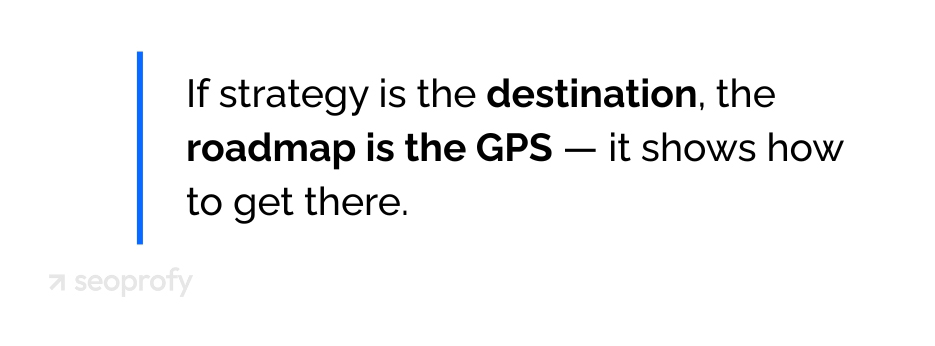
Say your SEO strategy includes a goal like “Grow organic blog traffic by 40% in 6 months.” The roadmap would break this down into executable steps:
- optimize internal linking
- improve meta descriptions on high-traffic posts
- publish eight new articles targeting keyword gaps
- and acquire backlinks from relevant sources.
How to Build a Strong SEO Roadmap
In this section, we’ll break down the process into practical, repeatable steps that any small business, startup, or in-house SEO team can apply.
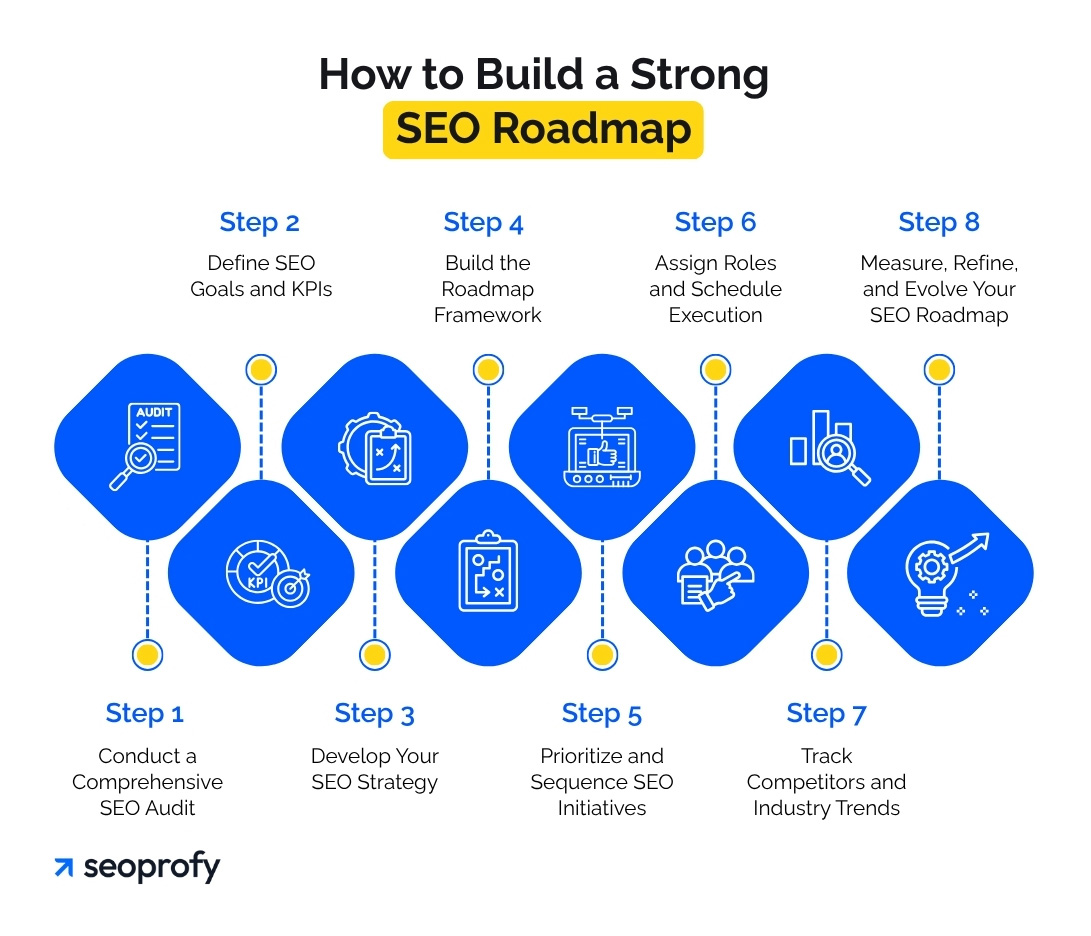
Step 1: Conduct a Comprehensive SEO Audit
Before building an SEO roadmap, you need to understand your current position. Skipping this step means making decisions based on assumptions, and SEO leaves little room for guesswork.
The audit provides a clear picture of your site’s strengths and weaknesses, a so-called competitive analysis. It’s where you identify technical issues, content gaps, and missed opportunities.
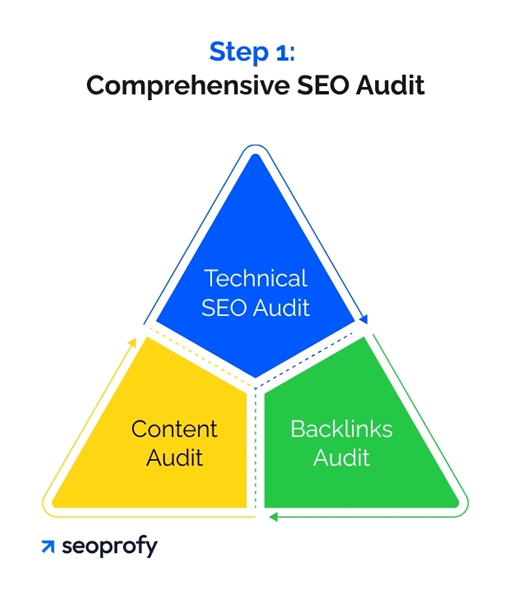
Technical SEO: The Foundation Check
Use Screaming Frog, Sitebulb, or Ahrefs Site Audit to flag:
- Broken links and nasty redirect loops
- Pages blocked from indexing (robots.txt, noindex title tags)
- Slow load times and poor INP scores
- Structural issues like orphan pages or duplicate titles
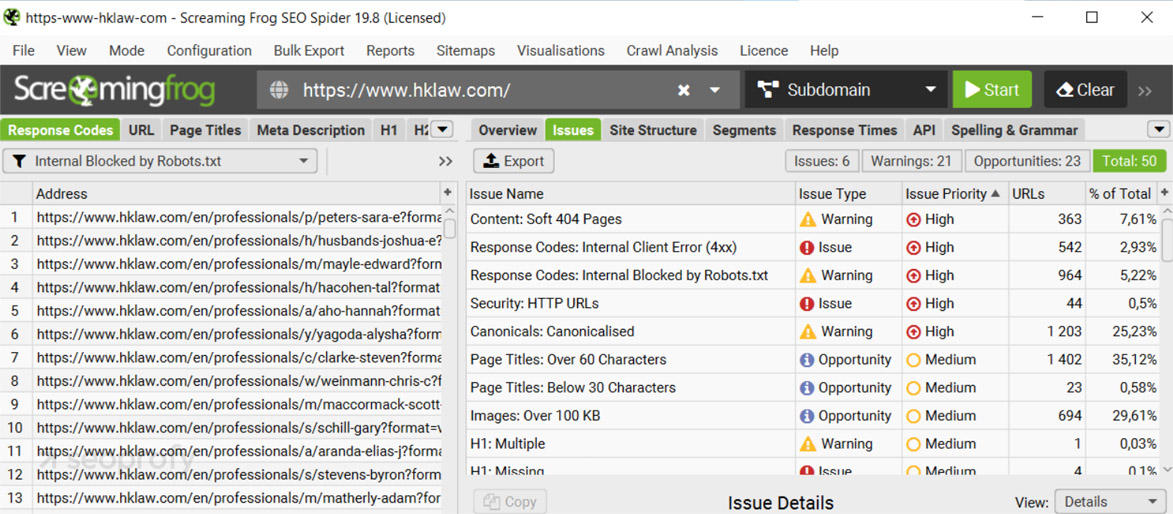
Content Audit: Identifying High-Impact vs. Underperforming Pages
Go into Google Search Console and see which pages are ranking, which are getting clicks, and which are not doing anything.
Ask yourself:
- Is this content targeting anything worth ranking for?
- Can I combine weak pages into something stronger?
- Which pages are outdated, off-brand, or irrelevant and should be refreshed?
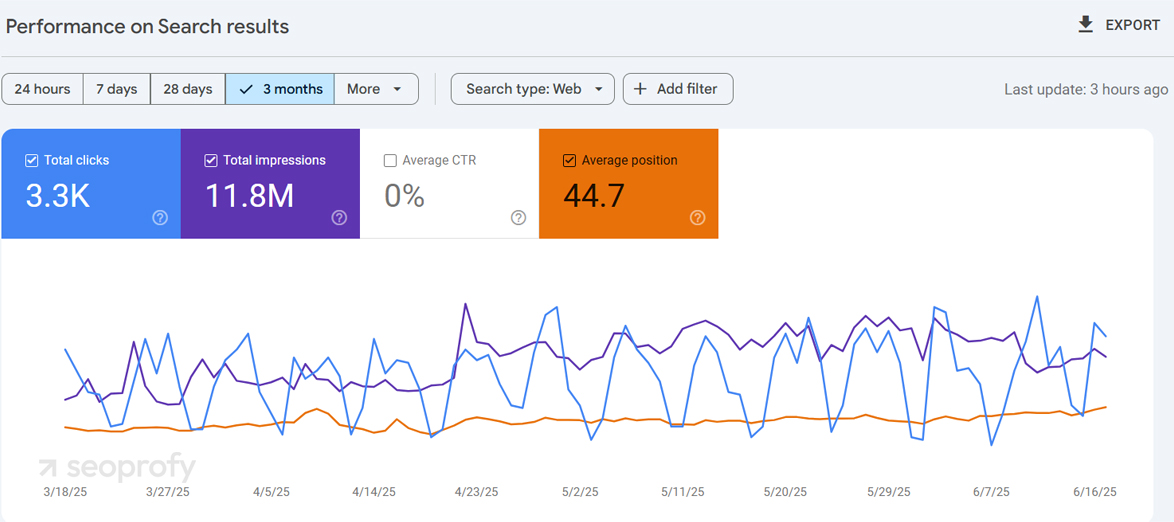
Backlinks: Authority Check
Now look outward. Is your site seen as legit? Or does it look like a ghost town to search engines?
Pull a backlink report in Ahrefs or Semrush. What you want to see:
- Authoritative links from real sites
- No spammy junk dragging your domain down
- Keywords opportunities your competitors are using that you’re not
Don’t just count links — look at which ones matter.
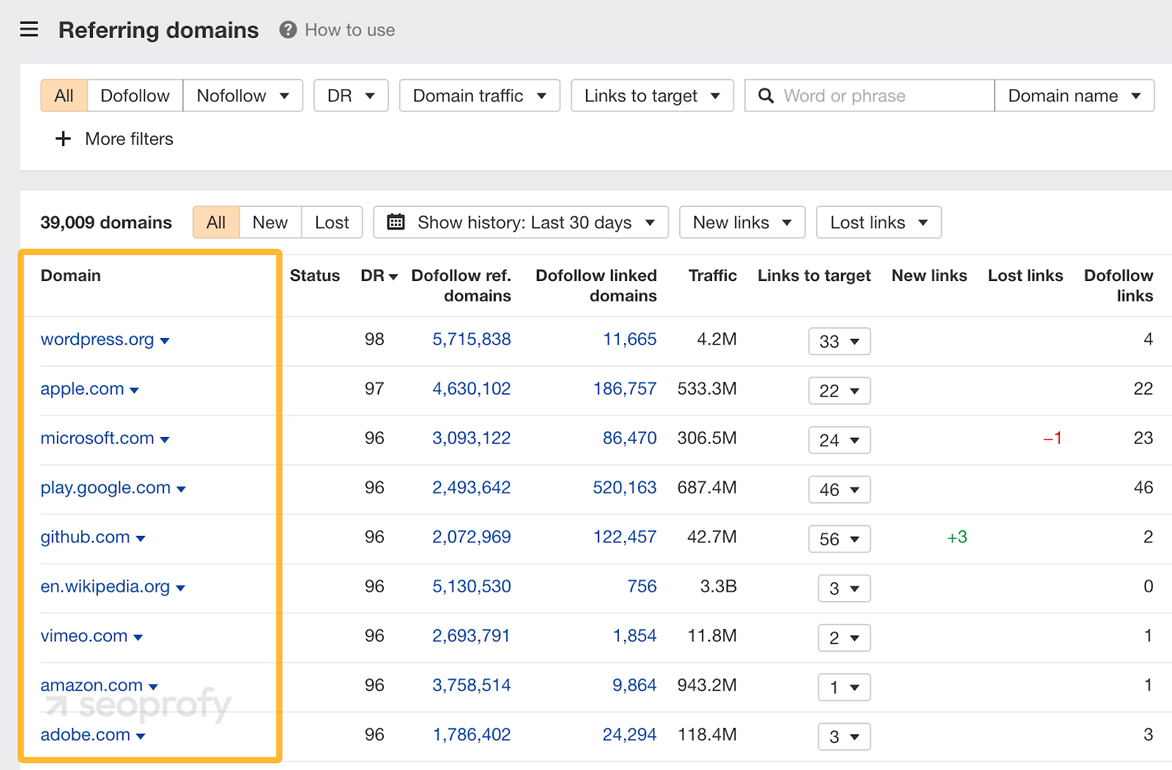
Step 2: Define SEO Goals and KPIs
Once your audit is done, it’s time to define exactly what success looks like. An efficient roadmap starts by turning audit insights into clear, measurable SEO goals tied to business outcomes.
SEO isn’t just about rankings — it’s a proven driver of business outcomes. In a survey by Databox, 70% of marketers said SEO delivers better sales performance than PPC. This highlights the need to set concrete, business-driven goals when building your SEO roadmap.
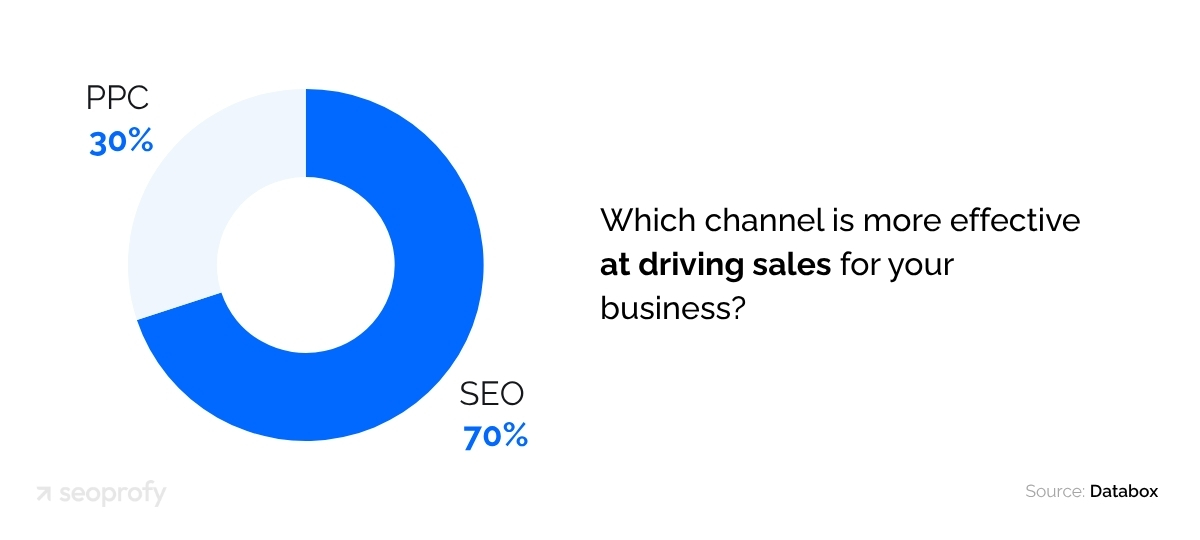
Set SMART SEO Goals
Good goals aren’t vague like “rank higher” or “get more traffic.” Make them SMART:
- Specific – Clearly state what you aim to achieve. Example: “Increase organic traffic by 40% in 6 months.”
- Measurable – Choose metrics that let you track progress and confirm when you´ve hit the goal.
- Attainable – Ground your goals in audit data and current SEO performance to ensure they are realistic.
- Relevant – Align SEO goals with broader business priorities, such as lead generation, online sales, or signups.
- Time-bound – Set deadlines to create urgency and keep execution on track.
Choose the Right KPIs
This is how you’ll track whether your SEO roadmap is working. Instead of listing metrics randomly, group them by purpose to make them easier to understand and apply:
Performance KPIs
- Organic traffic (Google Analytics)
- Keyword rankings over time
Engagement KPIs
- Engaged sessions (GA4)
- Average engagement time
- Pages per session
Conversion KPIs
- Lead form submissions
- Signups or purchases from organic traffic
- SEO ROI (revenue vs. SEO cost)
Step 3: Develop Your SEO Strategy
Now that your goals are locked in, it’s time to map out how you’ll reach them. Instead of chasing every possible SEO opportunity, your roadmap should focus on methods that directly support the outcomes you defined.
Choose Your Tactical Focus
Every site is different, but here are a few approaches that consistently move the needle:
- Target low-difficulty and long-tail keywords: They’re easier to rank for, especially if your domain is new. Compared to single-word searches, relevant keywords with ten to fifteen words get 1.76 times as many clicks.
- Build topical authority: Use content clusters and internal linking to dominate niche topics.
- Leverage programmatic SEO: In programmatic SEO, automate content generation for recurring formats (e.g., location/service pages).
- Optimize for SERP features: Think FAQ schema, featured snippets, and video/image packs.
Balance the SEO Pillars
Your SEO roadmap should balance efforts across three key areas:
- Technical (site speed, indexation, Core Web Vitals)
- On-page/content (keywords, structure, readability)
- Off-page (backlink profile, digital PR, domain authority)
A real strategy is repeatable. You don’t want to reinvent the wheel with every SEO campaign setup — you want a blueprint that works.
Step 4: Build the Roadmap Framework
This is the part where strategy becomes action. For teams working in Agile sprints or Scrum cycles, it can be integrated directly into backlog planning, ensuring SEO work—like white hat SEO tactics and choosing keywords with intent—moves forward alongside dev and content priorities.
Set monthly or quarterly checkpoints to review task progress, reassess priorities, and update the roadmap based on new data, team input, or algorithm changes. Whether you use tools like Notion, Jira, or Slack to manage workflows, the goal remains the same: keep SEO initiatives visible, accountable, and aligned with business objectives.
List and Prioritize Tasks
A raw task list isn’t enough — categorizing by function and frequency helps teams stay organized, allocate resources efficiently, and avoid bottlenecks.
Start by grouping your tasks into core functions:
- Technical: (e.g., improve site speed, fix 404s)
- Content: (e.g., publish blog clusters, optimize old articles)
- Off-page: (e.g., link building, digital PR)
Then, sort by frequency. Example:
- One-time: “Add schema markup to product pages”
- Ongoing: “Update blog meta descriptions monthly”
Add Key Details for Each Task
Here’s where most SEO strategies fail — they stop at listing what to do, but not how or who. Each task in your SEO roadmap should include:
- Priority level (High / Medium / Low)
- Estimated effort (hours/days or story points)
- Owner (e.g., content team, dev team, SEO lead)
- Deadline (don’t skip this — it creates accountability)
- Expected impact (e.g., traffic lift, CTR boost)
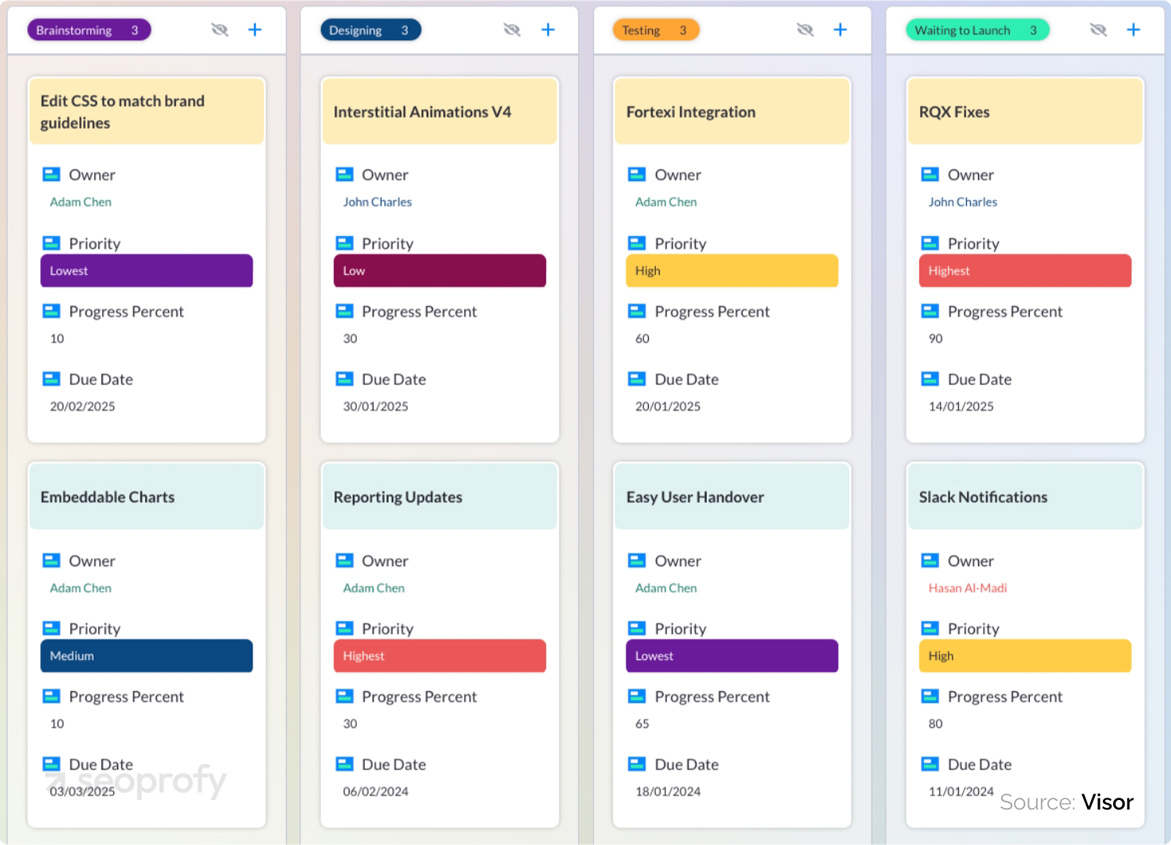
Choose the Right Format
Pick a format that your team will actually use.
- Spreadsheet: Simple and accessible; good for small teams
- Kanban board (Trello, Asana, ClickUp): Great for visualizing progress
- Gantt chart: Perfect for mapping campaigns with overlapping timelines
No matter what tool you use, the goal is the same: keep SEO visible, active, and trackable. And it’s not just theory — companies that document their marketing strategy are 414% more likely to report long-term success.
Step 5: Prioritize and Sequence SEO Initiatives
A strong SEO roadmap is about making smart decisions: what comes first, what can wait, and what you’re better off ignoring altogether.
There are simple, battle-tested ways to approach this. One of the most effective is the impact-versus-effort model. You look at each task and ask: how much SEO value will this bring, and how hard is it to implement? Quick wins like improving meta titles and meta descriptions, especially on high-impression pages, can lead to higher CTR.
Technical fixes like image compression help with speed and UX but do not directly impact CTR. On the other hand, tasks that are high in both value and effort, such as reorganizing service pages, improving internal linking, or consolidating overlapping content, should be scheduled with intention. An expert SEO company often uses this approach to ensure that every action in the roadmap delivers measurable results and contributes to long-term growth.
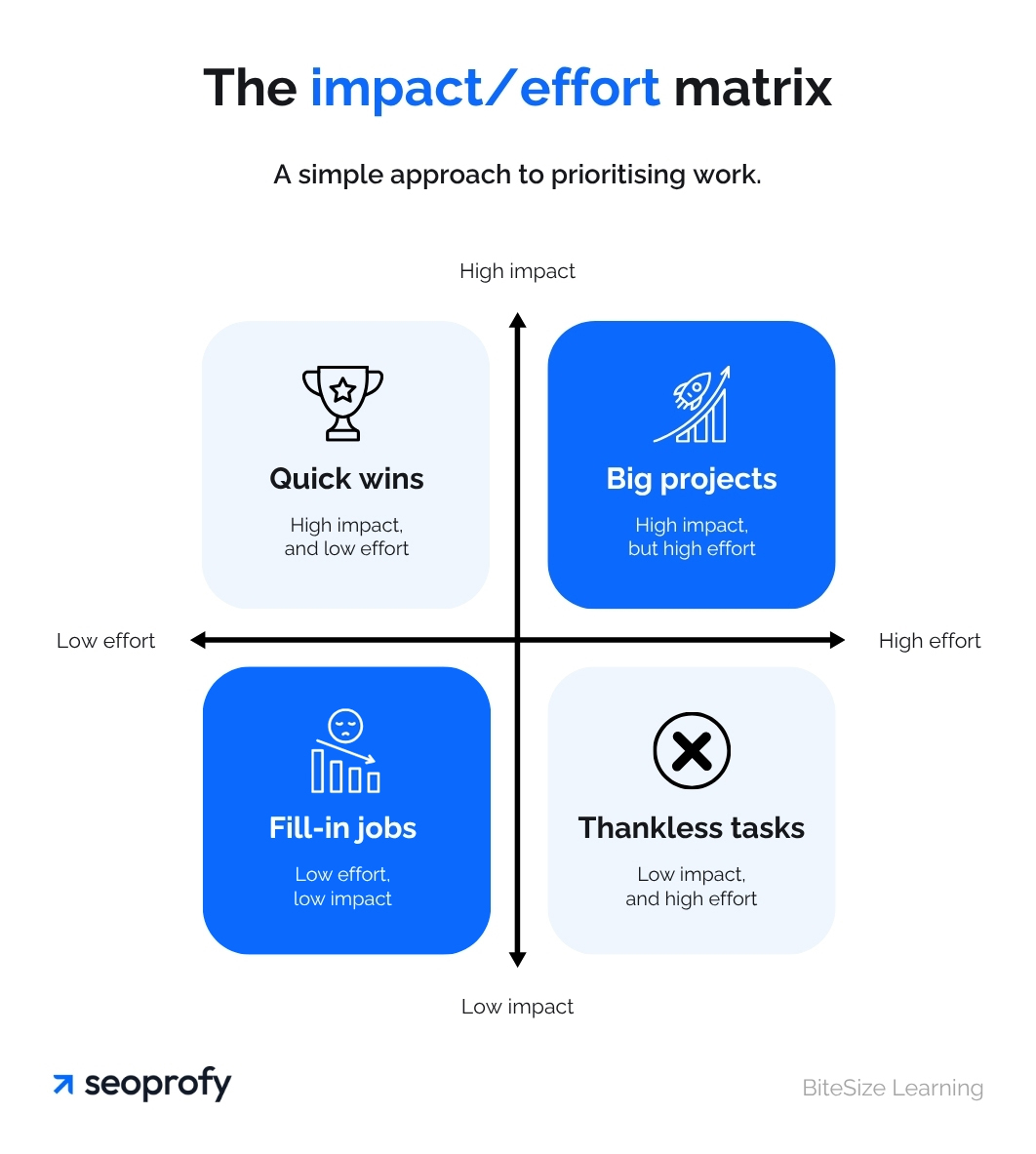
Another useful lens is the Eisenhower Matrix — a prioritization method that separates urgent tasks from important ones. Urgent tasks often demand attention but don’t always deliver impact. Your roadmap should help your team focus on what’s truly strategic, not just what feels pressing.
Quick wins matter — especially for building confidence and maintaining momentum. For example, optimizing your top-performing blog posts with stronger internal links or refreshing a few outdated articles can lead to immediate gains in traffic and engagement.
And when it comes to big, intimidating tasks, the key is to break them down. Let’s say you’re redesigning your service pages due to high bounce rates or poor user engagement. Start with a small group of high-priority pages, measure performance improvements, and scale based on results.
Step 6: Assign Roles and Schedule Execution
Execution breaks down when tasks lack ownership or happen out of order. A well-structured SEO roadmap prevents that by assigning roles, setting deadlines, and sequencing work logically.
Use this simple 3-step checklist to operationalize your roadmap:
- Assign Owners. Every task needs a clear owner. Define who’s responsible and who’s reviewing or supporting (e.g., content writer, dev, SEO lead).
- Set Deadlines and Priorities. Add realistic due dates based on team capacity and task complexity. Flag high-impact items and identify blockers early.
- Sequence by Dependency. Do the foundational work first. Technical fixes (e.g., indexing, speed) should happen before content updates or link outreach.
Tools like Asana, Trello, or Monday help track ownership and progress across teams. But frameworks aren’t enough unless they’re followed. Build in time for reviews, pivots, and testing — because even great plans need flexibility.

Step 7: Track Competitors and Industry Trends
Your SEO roadmap shouldn’t run in a vacuum. Competitor activity, algorithm updates, and shifting search behavior all influence what works — and what doesn’t.
Monitor Competitor Tactics
To keep your roadmap effective, you need to track what’s changing — both in your industry and on the SERP. Monitor competitor tactics, uncover keyword gaps, and analyze how their content and backlink strategies stack up against yours. Reviewing SEO case studies can also offer insights into what’s working in similar markets and help you benchmark your own progress.
Pay close attention to SERP features like featured snippets, “People Also Ask” boxes, and video carousels. On top of that, stay alert to Google algorithm updates, shifts in search behavior, and even evolving SEO pricing models that may influence how you allocate resources. If a major change hits, be ready to adjust your roadmap — it’s a living strategy, not a static one.
Align With Algorithm and SERP Changes
Google doesn’t send memos — but it does update its algorithms frequently. Some rollouts are minor, others can seriously shake your rankings. Review your roadmap at least once per quarter.
Track changes to core algorithms, shifts in SERP layouts (like AI-generated answers or new visual features), and updates to structured data requirements. Since organic search drives over 53% of all website traffic, even small changes can cut into visibility and conversions if you don’t adapt quickly.
Spot and Act on Trends
Use Google Trends, Reddit, and industry newsletters to stay ahead of shifting search intent. If interest in a topic spikes or search behavior shifts, refresh stale content.
Tired of vague advice and random blog tips?
Let’s build you a roadmap tailored to your business goals, target audience, and resources.
- Full SEO audit
- Tactical roadmap with timelines
- Real accountability
- Monthly check-ins and KPI tracking

Step 8: Measure, Refine, and Evolve Your SEO Roadmap
Launching your roadmap isn’t the finish line — it’s just the starting point. Set a performance review cadence (monthly or quarterly) to assess whether your efforts are paying off and where to adjust.
- Use dashboards in Google Looker Studio, Ahrefs, or your suitable best SEO tools to track key KPIs — organic traffic, rankings, CTR, conversion rates — in one place. Assign an SEO lead or analyst to interpret these results and flag underperformance trends.
- Underperformance isn’t just a red flag — it’s a signal. Review whether your content strategy missed search intent, the keywords lack volume, or technical blockers are dragging results down. Benchmark against past periods to identify patterns, not just snapshots.
- When changes are made, document them. Keep a changelog to track updates and learn from them.
- Keep the roadmap flexible — new competitors, algorithm updates, or internal business shifts can happen. Your ability to pivot with clarity is what turns a good roadmap into a resilient one.
Why SEO Roadmaps Actually Work
If you’ve made it this far, one thing should be clear: improvising your SEO efforts doesn’t lead to sustainable results. When you build an SEO roadmap, you’re not just managing tasks — you’re creating a system that prioritizes the right work, assigns ownership, and supports continuous improvement.
Roadmaps work because they give you perspective. They transform scattered initiatives into a structured, step-by-step plan tied to real business outcomes. You make decisions based on strategy, keyword research, and performance data.
This is what separates teams that grow from those that stall. A roadmap brings clarity, accountability, and momentum to your SEO journey. When you create an SEO roadmap, you align execution with business goals and establish a repeatable framework for scaling what works — ultimately driving consistent organic search traffic.
So if you haven’t already? Now’s the time to build an SEO roadmap with SEO experts tailored to your business, your team, and the results you want to achieve.













